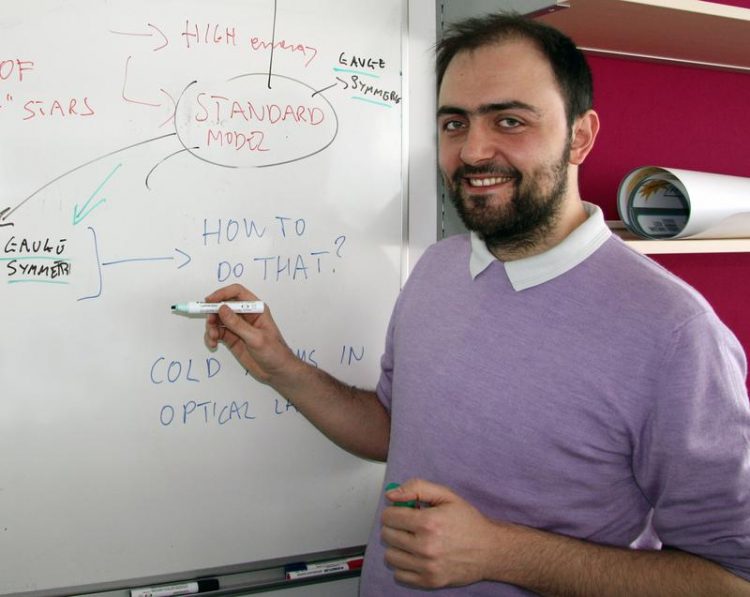Simulation of Chiral Edge States in a Quantum System

Theoretiker Marcello Dalmonte (Foto: Uni Innsbruck)
Condensed matter physics remains a field of study with many puzzles to solve. New studies have become possible due to advances in experimental quantum physics.
In particular, ultracold atoms in optical lattices and an environment that is fully tunable and controllable represent an ideal system for studying the physics of condensed matter problems. One of these phenomena can be observed in connection with the quantum Hall effect:
When certain materials are subjected to a strong magnetic field, the electrons cannot move in a singular circular direction at the edges anymore but repeatedly bounce against the edge, where they are reflected. This corresponds to skipping trajectories. As a macroscopic consequence so called chiral currents, which move in the opposite direction at the opposite edges, can be observed at the boundaries of such two-dimensional materials.
“You could compare it to a river where the fish swim towards the right on one bank and towards the left on the other bank,” explains theoretical physicist Marcello Dalmonte from the Institute for Theoretical Physics at the University of Innsbruck and a member of Peter Zoller’s research group at the Institute for Quantum Optics and Quantum Information of the Austrian Academy of Sciences.
Hopping atoms
Already ten years ago, Peter Zoller’s research team proposed a way to simulate chiral currents with neutral atoms. This idea combined with the synthetic dimension approach, put forward by the Barcelona group at ICFO, was picked up and implemented by physicists at the European Laboratory for Nonlinear Spectroscopy (LENS) in Florence collaborating with theoretical physicists in Innsbruck.
In their experiment, the scientists confined an ultracold gas of ytterbium atoms in an optical lattice generated by laser beams. As it is difficult to reproduce the structure of two-dimensional condensed matter systems, the physicists use a new approach: They used a one-dimensional chain of atoms and produced the second dimension synthetically. The dynamics along the synthetic dimension are generated by laser-induced hopping between two or three internal spin states.
“From a theoretical perspective this hopping into different internal spin states represents the same concept as the geometrical hopping of electrons at the edges of a condensed matter system,” explains Marcello Dalmonte. Together with Marie Rider and Peter Zoller, Marcello Dalmonte laid the theoretical groundwork for the experiment and suggested how to observe this phenomenon.
The observations published in Science show that the particles move mostly to the right at one edge and to the left on the other edge. “This behavior is very similar to chiral currents known in condensed matter physics,” says Dalmonte. This simulation of exotic effects opens up new ways for the researchers to study other new physical phenomena, for example, in connection with quantum Hall effects, the study of anyons in atomic systems. These exotic quasi particles are suggested to being suitable as the main building block for topological quantum computers.
The researchers are supported, among others, by the Austrian Science Fund (FWF), the European Research Council (ERC) and the European Union.
Publikation: Observation of chiral edge states with neutral fermions in synthetic Hall ribbons. M. Mancini, G. Pagano, G. Cappellini, L. Livi, M. Rider, J. Catani, C. Sias, P. Zoller, M. Inguscio, M. Dalmonte, L. Fallani. Science, Vol. 349 no. 6255 pp. 1510-1513
doi: 10.1126/science.aaa8736
Contact:
Marcello Dalmonte
Institute for Theoretical Physics
Universtity of Innsbruck and
Institute for Quantum Optics and Quantum Information
Austrian Academy of Sciences
Tel.: +43 512 507 4792
E-Mail: marcello.dalmonte@uibk.ac.at
Dr. Christian Flatz
Public Relations
Tel.: +43 512 507 32022
Mobil: +43 676 872532022
E-Mail: christian.flatz@uibk.ac.at
http://www.uibk.ac.at/th-physik/qo/ – Quantum Optics Theory Group
http://www.uibk.ac.at/th-physik/ – Institute for Theoretical Physics, Universtity of Innsbruck
http://iqoqi.at/ – Institute for Quantum Optics and Quantum Information
http://Austrian Academy of Sciences
http://www.lens.unifi.it/ – European Laboratory for Nonlinear Spectroscopy (LENS)
Media Contact
More Information:
http://www.uibk.ac.atAll latest news from the category: Physics and Astronomy
This area deals with the fundamental laws and building blocks of nature and how they interact, the properties and the behavior of matter, and research into space and time and their structures.
innovations-report provides in-depth reports and articles on subjects such as astrophysics, laser technologies, nuclear, quantum, particle and solid-state physics, nanotechnologies, planetary research and findings (Mars, Venus) and developments related to the Hubble Telescope.
Newest articles

Innovative 3D printed scaffolds offer new hope for bone healing
Researchers at the Institute for Bioengineering of Catalonia have developed novel 3D printed PLA-CaP scaffolds that promote blood vessel formation, ensuring better healing and regeneration of bone tissue. Bone is…

The surprising role of gut infection in Alzheimer’s disease
ASU- and Banner Alzheimer’s Institute-led study implicates link between a common virus and the disease, which travels from the gut to the brain and may be a target for antiviral…

Molecular gardening: New enzymes discovered for protein modification pruning
How deubiquitinases USP53 and USP54 cleave long polyubiquitin chains and how the former is linked to liver disease in children. Deubiquitinases (DUBs) are enzymes used by cells to trim protein…


